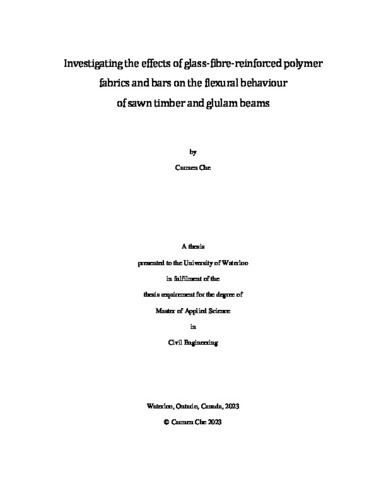| dc.description.abstract | As climate change becomes an increasingly pressing issue worldwide, the buildings and construction industry remains to be a significant contributor to global carbon emissions. To address this, construction materials with high amounts of embodied carbon, such as cement and steel, may be substituted for more renewable resources, such as wood and mass timber, in applications beyond what was historically thought possible. Achieving this goal relies on a comprehensive understanding of their solid mechanics; to compensate for a lack thereof, modern building codes implement stringent, conservative restrictions on using these comparatively unfamiliar materials. These requirements, along with growing needs to design for more extreme loads (e.g., seismic and blast), have prompted efforts to study and improve the performance of new and in-service wood structural elements, which themselves have evolved in recent decades beyond simply solid-sawn timber to include stronger, more efficiently engineered wood products such as glued-laminated (glulam) timber. One class of materials demonstrated to be well-suited for this task is fibre-reinforced polymer (FRP) composites, which come in a wide variety of forms and thus equally diverse applications.
The research presented herein investigates the effect of binding different types of glass-FRP reinforcement—specifically, in the forms of laminates of epoxy-impregnated glass-fibre fabric and of construction rebar—on the flexural behaviour different compositions of wood elements—specifically, sawn timber and glulam beams, composed of Spruce-Pine-Fir (SPF) No. 2, with dimensions of 140 mm × 140 mm × 2,025 mm and 110 mm × 140 mm × 2,025 mm, respectively. An FRP-to-wood ratio of 2% by cross-section area was used across eight reinforced specimens (two of each combination) for inter-comparison. An additional three control specimens were tested with no reinforcements to make a total of eleven beams in the study.
The results of the experiments found that the FRP fabric-laminates enhanced the strength by up to 52% and 36% in the sawn-timber and glulam beams, respectively. The bridging effect of natural defects in wood through the use of FRP as reinforcement resulted in a change in failure modes from the unreinforced beams. Due to cover requirements for FRP rebar, initial failure in this reinforcement configuration was still governed by the tensile strength of the extreme tension wood fibre; however, the stresses were subsequently transferred to the FRP bars, allowing for significant post-peak performance and greater overall sustained deformation. Analysis methods for predicting the strength of the reinforced beams were shown to be imprecise due to the highly variable nature of the natural wood material, demonstrating a need for larger sample sizes as well as tolerance for errors. | en |

